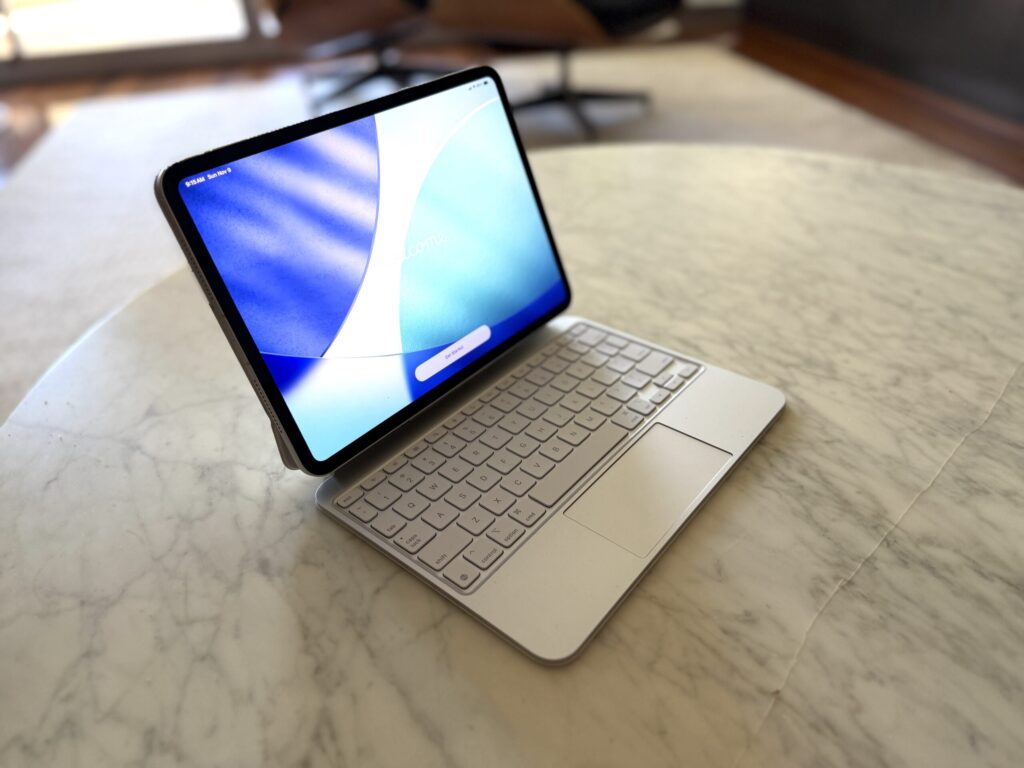
Apple’s iPad Pro continues to set the standard for tablets, and the 2025 model, powered by the new M5 chip, elevates performance to unprecedented heights. While the exterior remains largely unchanged from the 2024 model, the internal enhancements mark a significant leap forward. The latest iPad Pro retains its familiar design, finishes, and sizes—11-inch and 13-inch—alongside the acclaimed Tandem OLED Ultra Retina XDR display.
Having used both the M4 and M5 models extensively, the most notable advancements lie in power, connectivity, and subtle yet impactful quality-of-life improvements.
iPad Pro M5: Pricing and Variants
- 11-inch iPad Pro (Wi-Fi): $1,699
- 11-inch iPad Pro (Wi-Fi + Cellular): $2,049
- 13-inch iPad Pro (Wi-Fi): $2,199
- 13-inch iPad Pro (Wi-Fi + Cellular): $2,549
Unpacking the M5 Chip: Power and Performance
The M5 chip represents the latest evolution of Apple’s silicon, debuting in both the iPad Pro and the 14-inch MacBook Pro. It is crafted on Apple’s 3-nanometre process, ensuring a balance of power and efficiency. The base models come with a 9-core CPU, while the 1TB and 2TB variants feature an additional performance core, totaling ten.
According to Apple, the 10-core GPU includes neural accelerators that execute AI tasks up to 3.5 times faster than the M4. New shader cores and third-generation ray tracing are also 1.5 times faster than before. The upgraded Neural Engine enhances Apple Intelligence features, allowing more tasks to run swiftly with reduced power consumption. Memory bandwidth has increased to 153GB/sec, minimizing latency and accelerating heavy workloads. Base models now boast 12GB of unified memory, while higher storage options offer 16GB. Storage read and write speeds have doubled, significantly impacting tasks involving large video files or datasets.
Performance Benchmarks: Geekbench Insights
We conducted Geekbench 6 and Geekbench AI tests on the iPad Pro (M5), iPad Pro (M4), and iPad Air (M3) to evaluate performance differences:
Geekbench 6 Findings: The iPad Pro (M5) exhibits a notable performance lead, particularly in graphics workloads where its GPU outpaces the M4 and significantly surpasses the iPad Air (M3). While CPU gains are solid yet not dramatic, the M5’s overall performance makes it the most capable tablet for creative applications, gaming, and professional workloads.
Geekbench AI Findings: Reflecting Apple’s architectural shift, the M5 chip runs AI workloads across three accelerators—CPU, GPU, and Neural Engine—rather than relying solely on the Neural Engine. This approach enhances the M5’s GPU performance, benefiting larger, GPU-accelerated models and positioning the M5 as a future-ready device for next-generation AI applications.
Connectivity and Charging Innovations
Apple’s transition to in-house networking silicon marks another significant change. The new N1 wireless chip supports Wi-Fi 7, Bluetooth 6, and Thread for smart-home networking. Wi-Fi 7 promises higher speeds, improved stability, and lower latency, while Bluetooth 6 enhances energy efficiency and introduces precise accessory and location tracking capabilities.
The C1X modem offers up to 50% faster 5G speeds and improved power efficiency. The Wi-Fi + Cellular models now support up to eight eSIMs, catering to frequent travelers. For wired connections, the iPad Pro maintains Thunderbolt 3 and USB 4 support, enabling data transfer speeds up to 40 Gbps. Although Thunderbolt 5 would have been a welcome addition, the device still supports external displays up to 6K at 60Hz and 4K up to 120Hz with adaptive sync, which currently functions only at 4K resolution.
Apple has also introduced fast charging capabilities. Using a 60W or higher USB-C power adapter, the device can reach 50% battery in approximately 30 minutes.
Display, Cameras, and Accessories
The Tandem OLED Ultra Retina XDR display remains unchanged from the M4 model, yet it continues to be a standout feature. With a peak brightness of 1600 nits and full-screen brightness of 1000 nits, the display offers excellent color accuracy with P3 wide color support, a 120Hz ProMotion refresh rate, and perfect contrast due to OLED technology.
The camera setup remains solid, featuring a 12MP Centre Stage and Face ID cameras positioned on the long edge for natural video calls. The rear 12MP camera and LiDAR sensor support AR and 3D applications, though their usage may be limited for most users. All accessories from the previous generation are compatible with the M5 iPad Pro, including the Apple Pencil Pro, Magic Keyboard, and Smart Folio.
Who Should Consider the iPad Pro M5?
In everyday use, the M5 iPad Pro feels similar to the M4 unless pushed with demanding applications. For current M4 users whose devices meet their needs, upgrading may not be necessary. However, for new buyers or those seeking future-proofing for AI tools and heavy workflows, the M5 model is unparalleled. It is ideal for professionals involved in 4K–8K video editing, 3D rendering, live production, and machine learning applications. Gamers will also appreciate the enhanced ray-tracing performance, which promises console-class visuals as developers optimize for it.
Conclusion: A Refined and Powerful Tablet
The 2025 iPad Pro with the M5 chip refines an already world-class tablet, offering faster AI performance, increased memory, improved wireless connectivity, and fast charging, while retaining the same stunning display and design. For those serious about creative work, AI workflows, or seeking the most capable tablet available, the iPad Pro M5 is the definitive choice. For others, the 2024 M4 iPad Pro continues to provide exceptional value.







